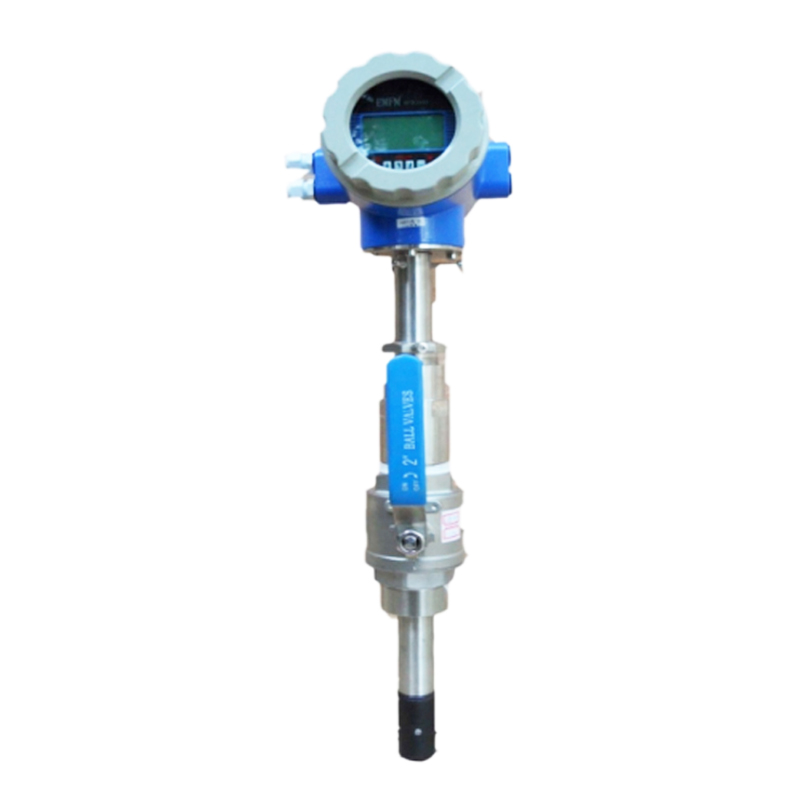The insertion type electromagnetic flowmeter is an economical and practical solution for flow measurement, especially for large diameter pipes. It measures the local flow rate by inserting a probe through the pipe wall into the fluid, which is easy and quick to install, at low cost, and without the need to cut off the pipe.
An insertion type magnetic flow meter is an electromagnetic flowmeter used to measure the flow of electrically conductive liquids in pipelines, and is characterized by the fact that the sensor (often referred to as a probe or insertion rod) can be inserted through the wall of the pipeline into the fluid to be measured without the need to completely cut off the pipeline or to replace the entire pipeline. This is a significant difference from traditional pipeline (all-pipe) electromagnetic flow meters.
Working Principle
The working principle of the insertion type electromagnetic flowmeter is similar to that of the traditional electromagnetic flowmeter and is still based on Faraday’s Law of Electromagnetic Induction. When the conductive liquid flows through the magnetic field around the probe, an induced electromotive force proportional to the flow rate will be generated. The electrodes on the probe detect this voltage signal, which is then processed by the transmitter and finally converted into a flow value.
It should be noted that insertion type electromagnetic flowmeter usually only measures the flow velocity at a specific location in the pipe, so its measurement accuracy will be affected by the distribution of the flow velocity in the pipe (flow velocity profile). In order to obtain a more accurate average flow rate, it is usually necessary to consider the correction of the flow profile or install multiple probes in the pipe.
Main components
- Sensor probe: This is the part that is inserted into the pipe and contains the excitation coil and one or more pairs of measuring electrodes. The shape and size of the probe is designed according to the size of the pipe and the fluid characteristics.
- Transmitter: This is the electronic unit mounted outside or near the pipe that generates the excitation current, amplifies and processes the weak voltage signal from the probe, and outputs a signal proportional to the flow rate.
- Mounting Components: These include flanges, welded bases, ball valves, etc., which are used to secure the probe to the pipeline and to enable insertion and removal.
Advantages
- Lower cost (especially for large diameter pipelines): Compared to installing a full-pipe electromagnetic flowmeter, the cost of an insertion flowmeter is usually much lower, especially on large diameter pipelines, because there is no need to purchase and install an expensive flowmeter body that is the same size as the pipeline.
- Quick and easy installation: The installation process usually does not require pipeline cut-off or extensive pipeline modification, but only need to cut holes in the pipeline and weld or flange the mounting base can be connected. This greatly reduces installation time and downtime.
- Easy maintenance: The probe can be removed through the installed valve for inspection, maintenance or replacement without stopping the pipeline.
- Wide range of applications: Can be applied to various pipe sizes, especially suitable for flow measurement of large diameter pipes.
- Lightweight: The sensor probes are relatively small and lightweight, making installation and transportation easier.
Applications
- Flow measurement in large diameter pipelines: This is the most common application scenario for insertion type electromagnetic flow meters, which can significantly reduce costs.
- Flow monitoring modification of existing pipelines: For already operating pipelines, the installation of insertion type flowmeter does not require large-scale pipeline modification.
- Low-cost flow monitoring: In the measurement accuracy requirements are not very high occasions, insertion type flowmeter is an economic choice.
- Temporary or Emergency Flow Measurement: Relatively easy to install and remove, and can be used for temporary flow monitoring needs.
- Water supply, wastewater treatment, irrigation and other industries: These industries usually use large diameter pipes and are more cost sensitive.


